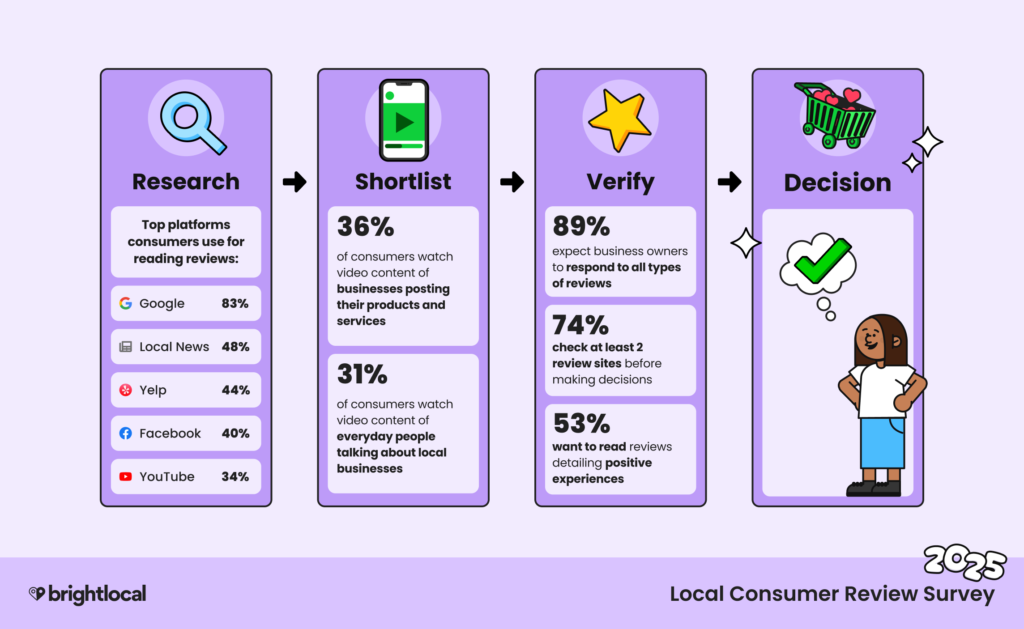Fifteen years on from the first edition, BrightLocal’s Local Consumer Review Survey 2025 offers a revealing snapshot of how consumers are finding, interpreting and contributing to online reviews. In a digital world increasingly influenced by video content, AI and shifting consumer expectations, reviews remain a cornerstone of local business discovery — but the rules are changing.
Here’s what senior marketers and local business owners need to take from this year’s findings.
Where are consumers finding local business reviews in 2025?
Google retains its position as the top review platform, with usage bouncing back after a slight dip in 2024. However, BrightLocal’s survey shows a growing trend towards alternative sources, with consumers increasingly consulting platforms like Trustpilot, YouTube, Instagram, and even local news websites. In fact, 48% of US adults turn to local news outlets for business reviews — highlighting the ongoing trust consumers place in regional journalism.
Meanwhile, use of AI tools such as ChatGPT to find reviews has decreased from 9% to 6%, despite greater adoption of AI in other areas of consumer behaviour. While some consumers associate AI with ‘fake’ content, BrightLocal’s blind test found that AI-generated responses were still preferred over human-written ones — a clear contradiction pointing to a lack of understanding around AI’s presence in online interactions.
What makes a review credible in 2025?
Trust in reviews continues to be nuanced. While overall star ratings still influence perception, detailed written experiences, photos, and videos are increasingly seen as more trustworthy. Consumers are now more willing to make decisions based on fewer reviews (under 50) and older content (six months to a year), suggesting a greater degree of leniency, particularly towards small and local businesses.
Despite this, trust in online reviews compared to personal recommendations has dropped significantly. In 2020, 79% of consumers trusted online reviews as much as recommendations from friends and family. In 2025, that figure has dropped to just 42%, according to BrightLocal. It appears consumers are reading reviews not to be persuaded, but to gather facts and form their own opinions.
Are consumers still writing reviews?
The survey shows that 96% of consumers are open to writing reviews, although only 29% did so in the past year. More people are writing about both positive and negative experiences, reflecting the desire for transparency and objectivity. However, many say their experience simply wasn’t noteworthy enough to comment on — a wake-up call for businesses that providing ‘average’ service is no longer enough.
Others believe their review won’t make a difference. For marketers, this presents an opportunity: reinforce messaging that consumer feedback genuinely impacts the business — not just in visibility but in customer experience and continuous improvement.
How should businesses ask for reviews?
BrightLocal’s 2025 data highlights email as the most effective review request method, with 40% of consumers saying they’d respond via that channel. In-person asks remain powerful too, especially in service-led sectors, while SMS and follow-up phone calls are seeing increased success post-purchase.
Timing is everything. For quick-turnaround industries like hospitality, 48% of consumers expect a review request the same day or by the following day. In contrast, more sensitive or higher-value services like healthcare or real estate call for a gentler approach, with most consumers preferring a review prompt within 3–7 days.
The role of AI in review management
AI’s role in review response management is growing. BrightLocal’s blind test again revealed that AI-written review replies were more positively received than human responses, particularly when they struck an emotional tone.
That said, nearly half of consumers still say AI-generated reviews feel ‘fake’, revealing a disconnect between perception and actual preference. Marketers can take advantage of AI to scale their review response strategy, but must ensure the tone remains human and personalised — especially in industries built on trust.
Key takeaways for marketers
The Local Consumer Review Survey 2025 makes it clear: review strategy in 2025 is about quality, credibility and experience, not just volume.
Consumers want facts. They are reading reviews for objectivity, not just reassurance.
Leniency is growing. People are more forgiving around review counts and recency, especially for small businesses.
Engagement matters. Responding to all types of feedback — positive and negative — builds trust.
AI is useful, if used wisely. Consumers appreciate well-written responses, even if AI-generated — just don’t let it feel robotic.
Video content is influential. With 77% of consumers consuming video when researching local businesses, businesses should consider integrating authentic, informative video into their content mix.
Ultimately, reviews are not just a touchpoint — they are part of the wider customer journey. Businesses that prioritise exceptional experiences, proactive reputation management, and cross-platform consistency are well-positioned to win in 2025.




RECOMMENDED FOR YOU
[STUDY] ChatGPT Powers Work And Life
OpenAI, in collaboration with Harvard economist David Deming, has…
OpenAI, in collaboration with Harvard economist David Deming, has…
LinkedIn Tests New Premium Tools for SMBs
LinkedIn is quietly piloting a new Premium offering designed…
LinkedIn is quietly piloting a new Premium offering designed…
Meta Brings AI Video Editing to Instagram and Meta AI
Meta has launched a new AI-powered video editing feature…
Meta has launched a new AI-powered video editing feature…